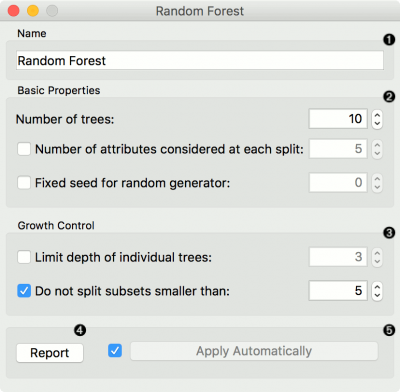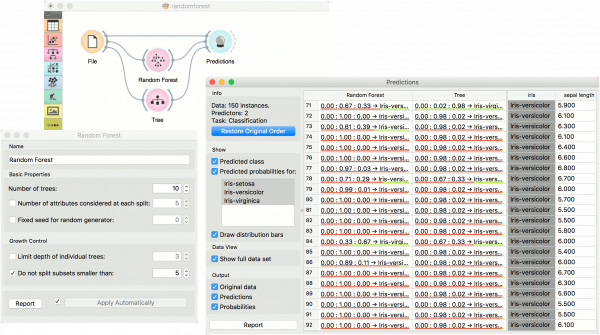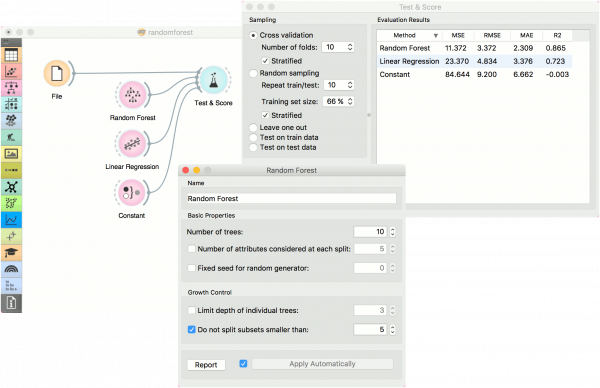Difference between revisions of "Orange: Random Forest"
Onnowpurbo (talk | contribs) |
Onnowpurbo (talk | contribs) (→Contoh) |
||
| (7 intermediate revisions by the same user not shown) | |||
| Line 2: | Line 2: | ||
| − | + | Widget Random Forest dapat memprediksi menggunakan sebuah ensemble (kumpulan / koleksi) dari decision tree. | |
| − | + | ==Input== | |
| − | + | Data: input dataset | |
| − | + | Preprocessor: preprocessing method(s) | |
| − | + | ==Output== | |
| − | + | Learner: random forest learning algorithm | |
| − | + | Model: trained model | |
| − | Random forest | + | Random forest adalah sebuah ensemble learning method yang digunakan untuk classification, regression dan tugas-tugas lainnya. Random forest pertama kali di usulkan oleh Tin Kam Ho dan di kembangkan lebih lanjut oleh Leo Breiman (Breiman, 2001) dan Adele Cutler. |
| − | Random Forest | + | Random Forest membangun sekumpulan decision tree. Setiap tree di kembangkan dari sebuah bootstrap sample dari training data. Ketika mengembangkan individual tree, subset acak dari atribut diambil (maka digunakan istilah "Random"), dari mana atribut terbaik untuk split (pemisahan) dipilih. Model terakhir didasarkan pada suara terbanyak dari individually developed tree di forest. |
| − | Random Forest | + | Random Forest dapat digunakan untuk task (tugas) klasifikasi dan regresi. |
| − | [[File:RandomForest-stamped.png|center| | + | [[File:RandomForest-stamped.png|center|400px|thumb]] |
| − | + | * Specify the name of the model. The default name is “Random Forest”. | |
| − | + | * Specify how many decision trees will be included in the forest (Number of trees in the forest), and how many attributes will be arbitrarily drawn for consideration at each node. If the latter is not specified (option Number of attributes… left unchecked), this number is equal to the square root of the number of attributes in the data. You can also choose to fix the seed for tree generation (Fixed seed for random generator), which enables replicability of the results. | |
| − | + | * Original Breiman’s proposal is to grow the trees without any pre-pruning, but since pre-pruning often works quite well and is faster, the user can set the depth to which the trees will be grown (Limit depth of individual trees). Another pre-pruning option is to select the smallest subset that can be split (Do not split subsets smaller than). | |
| − | + | * Produce a report. | |
| − | + | * Click Apply to communicate the changes to other widgets. Alternatively, tick the box on the left side of the Apply button and changes will be communicated automatically. | |
==Contoh== | ==Contoh== | ||
| − | + | Untuk contoh classification task, kita menggunakan dataset iris. Menghubungkan Widget Random Forest ke Widget Predictions. Dengan menghubungkan Widget File ke Widget Random Forest dan Widget Tree dan hubungkan mereka ke Widget Predictions. Akhirnya, kita bisa memperhatikan prediksi dari ke dua model. | |
| − | [[File:RandomForest-classification.png|center| | + | [[File:RandomForest-classification.png|center|600px|thumb]] |
| − | + | Untuk contoh regression task, kita menggunakan dataset housing. Disini, kita akan membandingkan beberapa model yang berbeda, yaitu, widget Random Forest, widget Linear Regression dan widget Constant, di Widget Test & Score. | |
| − | |||
| − | |||
| + | [[File:RandomForest-regression.png|center|600px|thumb]] | ||
==Referensi== | ==Referensi== | ||
Latest revision as of 08:16, 6 April 2020
Sumber: https://docs.biolab.si//3/visual-programming/widgets/model/randomforest.html
Widget Random Forest dapat memprediksi menggunakan sebuah ensemble (kumpulan / koleksi) dari decision tree.
Input
Data: input dataset Preprocessor: preprocessing method(s)
Output
Learner: random forest learning algorithm Model: trained model
Random forest adalah sebuah ensemble learning method yang digunakan untuk classification, regression dan tugas-tugas lainnya. Random forest pertama kali di usulkan oleh Tin Kam Ho dan di kembangkan lebih lanjut oleh Leo Breiman (Breiman, 2001) dan Adele Cutler.
Random Forest membangun sekumpulan decision tree. Setiap tree di kembangkan dari sebuah bootstrap sample dari training data. Ketika mengembangkan individual tree, subset acak dari atribut diambil (maka digunakan istilah "Random"), dari mana atribut terbaik untuk split (pemisahan) dipilih. Model terakhir didasarkan pada suara terbanyak dari individually developed tree di forest.
Random Forest dapat digunakan untuk task (tugas) klasifikasi dan regresi.
- Specify the name of the model. The default name is “Random Forest”.
- Specify how many decision trees will be included in the forest (Number of trees in the forest), and how many attributes will be arbitrarily drawn for consideration at each node. If the latter is not specified (option Number of attributes… left unchecked), this number is equal to the square root of the number of attributes in the data. You can also choose to fix the seed for tree generation (Fixed seed for random generator), which enables replicability of the results.
- Original Breiman’s proposal is to grow the trees without any pre-pruning, but since pre-pruning often works quite well and is faster, the user can set the depth to which the trees will be grown (Limit depth of individual trees). Another pre-pruning option is to select the smallest subset that can be split (Do not split subsets smaller than).
- Produce a report.
- Click Apply to communicate the changes to other widgets. Alternatively, tick the box on the left side of the Apply button and changes will be communicated automatically.
Contoh
Untuk contoh classification task, kita menggunakan dataset iris. Menghubungkan Widget Random Forest ke Widget Predictions. Dengan menghubungkan Widget File ke Widget Random Forest dan Widget Tree dan hubungkan mereka ke Widget Predictions. Akhirnya, kita bisa memperhatikan prediksi dari ke dua model.
Untuk contoh regression task, kita menggunakan dataset housing. Disini, kita akan membandingkan beberapa model yang berbeda, yaitu, widget Random Forest, widget Linear Regression dan widget Constant, di Widget Test & Score.
Referensi
Breiman, L. (2001). Random Forests. In Machine Learning, 45(1), 5-32. Available here.


